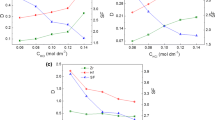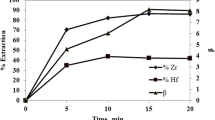Abstract
The preparation of nuclear-grade zirconium and hafnium is very important for nuclear power. The separation of hafnium from zirconium in a hydrochloric acid solution by solvent extraction was investigated with di(2-ethylhexyl)phosphoric acid (D2EHPA). The effects of hydrochloric acid concentration, extractant concentration, diluents, and temperature on the distribution coefficient of hafnium and zirconium were studied. The species extracted were ZrOA2·2HA and HfOA2·2HA. In this process, the separation factors varied with different diluents and followed the order octane > hexane > toluene > chloroform. A high separation factor value of 4.16 was obtained under the conditions of a solution containing 0.05 mol/L HCl and 0.01 mol/L D2EHPA for the separation of hafnium from zirconium. The extraction reaction was endothermic.






Similar content being viewed by others
References
Z. Xu, L. Wang, M. Wu, Y. Xu et al., Separation of zirconium and hafnium by solvent extraction using mixture of DIBK and P204. Hydrometallurgy 165, 275–281 (2016). https://doi.org/10.1016/j.hydromet.2016.01.032
Z.-G. Xu, L. Wang, Y.-K. Wu et al., Solvent extraction of hafnium from thiocyanic acid medium in DIBK-TBP mixed system. Trans Nonferr. Met. Soc. 22, 1760–1765 (2012). https://doi.org/10.1016/S1003-6326(11)61384-8
M. Smolik, A. Jakóbik-Kolon, M. Porański, Separation of zirconium and hafnium using Diphonix® chelating ion-exchange resin. Hydrometallurgy 95, 350–353 (2009). https://doi.org/10.1016/j.hydromet.2008.05.010
L.Y. Wang, M.S. Lee, Development of a separation process for the selective extraction of hafnium(IV) over zirconium(IV) from sulfuric acid solutions by using D2EHPA. Hydrometallurgy 160, 12–17 (2016). https://doi.org/10.1016/j.hydromet.2015.11.013
L.Y. Wang, M.S. Lee, A review on the aqueous chemistry of Zr(IV) and Hf(IV) and their separation by solvent extraction. J. Ind. Eng. Chem. 39, 1–9 (2016). https://doi.org/10.1016/j.jiec.2016.06.004
B. Gupta, P. Malik, N. Mudhar, extraction and recovery of zirconium from zircon using Cyanex 923. Solv. Extr. Ion Exch. 23, 345–357 (2005). https://doi.org/10.1081/SEI-200050005
L.Y. Wang, H.Y. Lee, M.S. Lee, Solvent extractive separation of zirconium and hafnium from hydrochloric acid solutions by organophosphorous extractants and their mixtures with other types of extractants. Chem. Eng. Commun. 202, 1289–1295 (2015). https://doi.org/10.1080/00986445.2014.921621
M.S. Lee, R. Banda, S.H. Min, Separation of Hf(IV)–Zr(IV) in H2SO4 solutions using solvent extraction with D2EHPA or Cyanex 272 at different reagent and metal ion concentrations. Hydrometallurgy 152, 84–90 (2015). https://doi.org/10.1016/j.hydromet.2014.12.005
L.Y. Wang, M.S. Lee, Separation of Zr and Hf from sulfuric acid solutions with amine-based extractants by solvent extraction. Sep. Purif. Technol. 142, 83–89 (2015). https://doi.org/10.1016/j.seppur.2015.01.001
R. Banda, M.S. Lee, Solvent extraction for the separation of Zr and Hf from aqueous solutions. Sep. Purif. Rev. 44, 199–215 (2015). https://doi.org/10.1080/15422119.2014.920876
M. Aliakbari, K. Saberyan, M. Noaparast et al., Separation of hafnium and zirconium using TBP modified ferromagnetic nanoparticles: effects of acid and metals concentrations. Hydrometallurgy 146, 72–75 (2014). https://doi.org/10.1016/j.hydromet.2014.03.002
M. Taghizadeh, M. Ghanadi, E. Zolfonoun, Separation of zirconium and hafnium by solvent extraction using mixture of TBP and Cyanex 923. J. Nucl. Mater. 412, 334–337 (2011). https://doi.org/10.1016/j.jnucmat.2011.03.033
G. Pandey, S. Mukhopadhyay, A.U. Renjith et al., Recovery of Hf and Zr from slurry waste of zirconium purification plant using solvent extraction. Hydrometallurgy 163, 61–68 (2016). https://doi.org/10.1016/j.hydromet.2016.03.005
B.R. Reddy, J.R. Kumar, Studies on liquid–liquid extraction of tetravalent hafnium from weakly hydrochloric acid solutions by LIX 84-IC. Sep. Purif. Technol. 42, 169–174 (2005). https://doi.org/10.1016/j.seppur.2004.07.010
J.S. Gaudh, V.M. Shinde, Analytical separation of titanium(IV), zirconium(IV) and hafnium(IV) using tris(2-ethylhexyl)phosphate as an extractant. Anal. Lett. 28, 1107–1125 (1995). https://doi.org/10.1080/00032719508002682
J. Kumar, B. Reddy, J. Koduru et al., Liquid-liquid extraction of tetravalent hafnium from acidic chloride solutions using bis(2,4,4-trimethylpentyl) dithiophosphinic acid (Cyanex 301). Sep. Sci. Technol. 42, 865–877 (2007). https://doi.org/10.1080/01496390601173986
R. Banda, H.Y. Lee, M.S. Lee, Separation of Zr from Hf in hydrochloric acid solution using amine-based extractants. Ind. Eng. Chem. Res. 51, 9652–9660 (2012). https://doi.org/10.1021/ie3008264
S. Chen, Z. Zhang, S. Kuang et al., Separation of zirconium from hafnium in sulfate medium using solvent extraction with a new reagent BEAP. Hydrometallurgy 169, 607–611 (2017). https://doi.org/10.1016/j.hydromet.2017.04.001
R. Banda, H.Y. Lee, M.S. Lee, Separation of Zr from Hf in acidic chloride solutions by using TOPO and its mixture with other extractants. J. Radioanal. Nucl. Ch. 298, 259–264 (2013). https://doi.org/10.1007/s10967-012-2349-y
B. Ramachandra Reddy, J. Rajesh Kumar, K. Phani Raja et al., Solvent extraction of Hf(IV) from acidic chloride solutions using Cyanex 302. Miner. Eng. 17, 939–942 (2004). https://doi.org/10.1016/j.mineng.2004.04.004
R.G. Pearson, Hard and soft acid and bases. J. Am. Chem. Soc. 85, 3533–3539 (1963). https://doi.org/10.1016/B978-0-12-395706-1.50007-8
A. Boussaha, J.C. Abbe, A. Haessler, Influence of the acidity on the polymerisation of Hf(IV) in aqueous solutions of HfOCl2 observed by the time differential perturbed angular correlation technique. J. Inorg. Nucl. Chem. 39, 853–855 (1977). https://doi.org/10.1016/0022-1902(77)80168-1
R.K. Biswas, M.A. Hayat, Solvent extraction of zirconium(IV) from chloride media by D2EHPA in kerosene. Hydrometallurgy 63, 149–158 (2002). https://doi.org/10.1016/S0304-386X(01)00220-1
L.Y. Wang, M.S. Lee, Separation of zirconium and hafnium from nitric acid solutions with LIX 63, PC 88A and their mixture by solvent extraction. Hydrometallurgy 150, 153–160 (2014). https://doi.org/10.1016/j.hydromet.2014.10.009
H. Lee, S. Gyu Kim, J. Kee Oh, Stoichiometric relation for extraction of zirconium and hafnium from acidic chloride solutions with Versatic Acid 10. Hydrometallurgy 73, 91–97 (2004). https://doi.org/10.1016/j.hydromet.2003.08.004
M. Taghizadeh, R. Ghasemzadeh, S.N. Ashrafizadeh et al., Determination of optimum process conditions for the extraction and separation of zirconium and hafnium by solvent extraction. Hydrometallurgy 90, 115–120 (2008). https://doi.org/10.1016/j.hydromet.2007.10.002
B.V. Pershina, D. Trubert, C. Le Naour et al., Theoretical predictions of hydrolysis and complex formation of group-4 elements Zr, Hf and Rf in HF and HCl solutions. Radiochim. Acta 90, 869–877 (2002). https://doi.org/10.1524/ract.2002.90.12_2002.869
B. Reddy, R.K. Jyothi, A. Reddy, Solvent extraction of tetravalent hafnium from acidic chloride solutions using 2-ethyl hexyl phosphonic acid mono-2-ethyl hexyl ester (PC-88A). Miner. Eng. 17, 553–556 (2004). https://doi.org/10.1016/j.hydromet.2003.07.002
X.-J. Peng, Y. Cui, J.-F. Ma et al., Extraction of lanthanide ions with N, N, N′, N′-tetrabutyl-3-oxa-diglycolamide from nitric acid media. Nucl. Sci. Tech. 28, 87 (2017). https://doi.org/10.1007/s41365-017-0229-4
Author information
Authors and Affiliations
Corresponding authors
Additional information
This work was supported by the Natural Science Foundation of Shandong Province (No. ZR201702160381).
Rights and permissions
About this article
Cite this article
Yang, T., Sun, GX., Qian, Y. et al. Separation of hafnium from zirconium in hydrochloric acid solution with di(2-ethylhexyl)phosphoric acid by solvent extraction. NUCL SCI TECH 30, 22 (2019). https://doi.org/10.1007/s41365-019-0548-8
Received:
Revised:
Accepted:
Published:
DOI: https://doi.org/10.1007/s41365-019-0548-8




